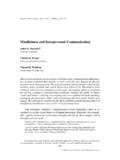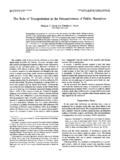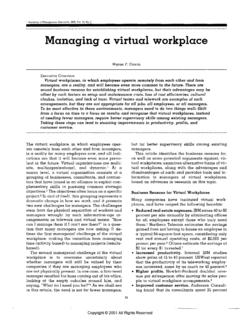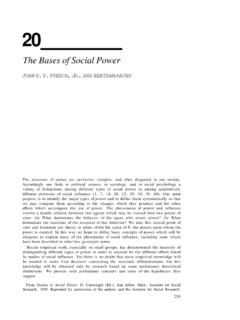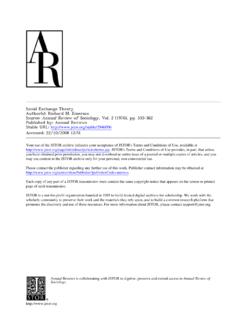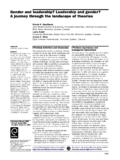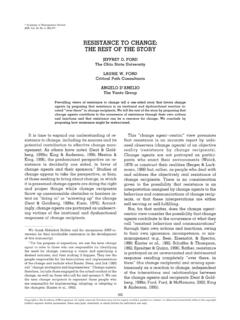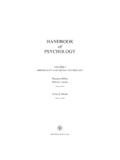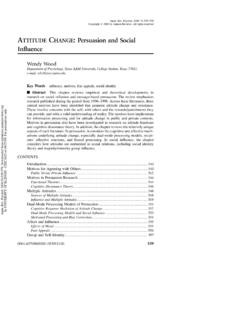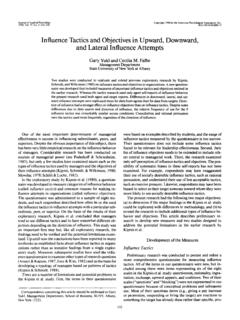Transcription of Ron Fisher, Ph.D., International Peace and Conflict ...
1 1 Sources of Conflict and Methods of Conflict resolution Ron Fisher, , International Peace and Conflict resolution School of International Service The American University c. 1977, Rev. 1985, 2000. Introduction: Conflict occurs between people in all kinds of human relationships and in all social settings. Because of the wide range of potential differences among people, the absence of Conflict usually signals the absence of meaningful interaction. Conflict by itself is neither good nor bad. However, the manner in which Conflict is handled determines whether it is constructive or destructive (Deutsch & Coleman, 2000). Conflict is defined as an incompatibility of goals or values between two or more parties in a relationship, combined with attempts to control each other and antagonistic feelings toward each other (Fisher, 1990).
2 The incompatibility or difference may exist in reality or may only be perceived by the parties involved. Nonetheless, the opposing actions and the hostile emotions are very real hallmarks of human Conflict . Conflict has the potential for either a great deal of destruction or much creativity and positive social change (Kriesberg, 1998). Therefore, it is essential to understand the basic processes of Conflict so that we can work to maximize productive outcomes and minimize destructive ones. This paper will briefly describe some common sources of Conflict , the levels of social interaction at which Conflict occurs, and the general strategies of approaching Conflict that are available. Sources of Conflict : Early reviews in the field of Conflict resolution identified a large number of schemes for describing sources or types of Conflict (Fink, 1968; Mack & Snyder, 1958).
3 One of the early theorists on Conflict , Daniel Katz (1965), created a typology that distinguishes three main sources of Conflict : economic, value, and power. 1. Economic Conflict involves competing motives to attain scarce resources. Each 2party wants to get the most that it can, and the behavior and emotions of each party are directed toward maximizing its gain. Union and management Conflict often has as one of its sources the incompatible goals of how to slice up the economic pie . 2. Value Conflict involves incompatibility in ways of life, ideologies the preferences, principles and practices that people believe in. International Conflict ( , the Cold War) often has a strong value component, wherein each side asserts the rightness and superiority of its way of life and its political-economic system.
4 3. Power Conflict occurs when each party wishes to maintain or maximize the amount of influence that it exerts in the relationship and the social setting. It is impossible for one party to be stronger without the other being weaker, at least in terms of direct influence over each other. Thus, a power struggle ensues which usually ends in a victory and defeat, or in a stand-off with a continuing state of tension. Power conflicts can occur between individuals, between groups or between nations, whenever one or both parties choose to take a power approach to the relationship. Power also enters into all Conflict since the parties are attempting to control each other. It must be noted that most conflicts are not of a pure type, but involve a mixture of sources.
5 For example, union-management Conflict typically involves economic competition, but may also take the form of a power struggle and often involves different ideologies or political values. The more sources that are involved, the more intense and intractable the Conflict usually is. Another important source of Conflict is ineffective communication. Miscommunication and misunderstanding can create Conflict even where there are no basic incompatibilities. In addition, parties may have different perceptions as to what are the facts in a situation, and until they share information and clarify their perceptions, resolution is impossible. Self-centeredness, selective perception, emotional bias, prejudices, etc.
6 , are all forces that lead us to perceive situations very differently from the other party. Lack of skill in communicating what we really mean in a clear and respectful fashion often results in confusion, hurt and anger, all of which simply feed the Conflict process. Whether the Conflict has objective sources or is due only to perceptual or communication problems, it is experienced as very real by the parties involved. Escalation of Conflict : A final source of Conflict is more additional than basic, that is, it comes in after the Conflict has started. conflicts have a definite tendency to escalate, , to become more intense and hostile, and to develop more issues, , what the parties say the Conflict is about.
7 Therefore, escalating conflicts become more difficult to manage. The process of escalation feeds on fear and defensiveness. Threat leads to counterthreat, usually with higher stakes at each go-round. Selective and distorted perception justifies a competitive and cautious approach as opposed to a trusting and cooperative one. Through Deutsch s crude law of social relations (1973), competition breeds 3competition, rather than cooperation. The self-fulfilling prophecy comes into play. Each party believes in the evil intentions of the other and the inevitability of disagreement, and therefore takes precautionary actions which signal mistrust and competitiveness (Blake, Shepard & Mouton, 1964). When the other party then responds with a counteraction, this is perceived as justifying the initial precautionary measure, and a new spiral of action and counteraction begins.
8 Through the norm of reciprocity, stronger attempts to control are met not only with stronger resistance, but more contentious attempts to gain the upper hand. With each succeeding spiral of Conflict , polarization grows and the parties become more adamant and intransigent in their approach to the situation. Even though the intensity of the Conflict may moderate for periods of time, the issues remain, and a triggering event induces conflictual behavior with negative consequences, and the Conflict has moved one more step up the escalation staircase. When parties become locked in to a Conflict they are usually unable to get out by themselves, and the intervention of a third party in the role of arbitrator, mediator or consultant may be required (Fisher, 1972, 1997).
9 Levels of Conflict : Conflict can occur at a number of levels of human functioning. Conflict in your head between opposing motives or ideas is shown by your internal dialogue and is at the intrapersonal level. Beyond that, the primary concern here is with social Conflict , , Conflict between people whether they are acting as individuals, as members of groups, or as representatives of organizations or nations. Interpersonal Conflict occurs when two people have incompatible needs, goals, or approaches in their relationship. Communication breakdown is often an important source of interpersonal Conflict and learning communication skills is valuable in preventing and resolving such difficulties. At the same time, very real differences occur between people that cannot be resolved by any amount of improved communication.
10 Personality Conflict refers to very strong differences in motives, values or styles in dealing with people that are not resolvable. For example, if both parties in a relationship have a high need for power and both want to be dominant in the relationship, there is no way for both to be satisfied, and a power struggle ensues. Common tactics used in interpersonal power struggles include the exaggerated use of rewards and punishments, deception and evasion, threats and emotional blackmail, and flattery or ingratiation. Unresolved power Conflict usually recycles and escalates to the point of relationship breakdown and termination. Role Conflict involves very real differences in role definitions, expectations or responsibilities between individuals who are interdependent in a social system.
